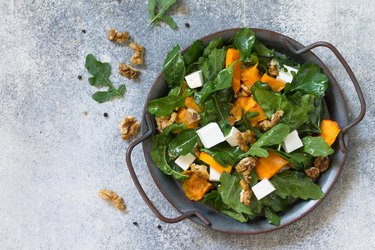
Just as abs are "made in the kitchen," so is well-controlled blood sugar. For people with diabetes, careful attention to detail — right down to the ingredients that go into your salad dressing — helps you keep everything under control.
Not All Dressings Are Equal
Video of the Day
If you're using store-bought salad dressings, get used to the idea of reading the labels. Carbohydrate counting is one of the strategies recommended by the American Diabetes Association (ADA) for regulating your food intake, controlling your blood sugar and, if you take insulin, making sure you get the right amount.
Video of the Day
Those labels in the salad dressing aisle are a good place to start: Even "light" salad dressings can contain several grams of carbohydrate per 1- or 2-tablespoon serving — and many people use a lot more than that on their salads without realizing they're exceeding the recommended serving size. The ADA describes 2 tablespoons as a standard serving for salad dressing — although some labels might list nutrition facts for a 1-tablespoon serving, so always check the listed serving size.
The carbohydrate section of your salad dressing label will also list any added sugars, which are part of the total carbohydrate count. Added sugar, or a long list of barely comprehensible ingredients, are good clues that a particular salad dressing might not be for you.
When you shop for salad dressing, the ADA recommends vinaigrettes (a mix of oil and vinegar) for the most frequent consumption. Watch out for super-creamy dressings such as ranch and bleu cheese — the ADA lists these as foods to avoid — and limit your intake of low-fat creamy dressings, such as light ranch, to occasional treats.
Best Sugar-Free Salad Dressing
If you're struggling to find a store-bought salad dressing for people with diabetes, why not make your own? The Centers for Disease Control and Prevention recommends the classic, simple pairing of olive oil and vinegar — a DIY vinaigrette.
Other healthy oils you can use include canola oil, safflower oil and sesame oil; the American Heart Association lists all three for their heart-healthy unsaturated fat content. You can also choose between interesting vinegars, such as red wine vinegar, balsamic vinegar and apple cider vinegar; or purchase or make herb- and spice-infused flavored vinegars. Just check the label to make sure you're not buying hidden sweeteners too.
Finally, add any additional flavorings. These can range from citrus fruit or juice such as lemons and oranges to berries, spices, minced red onion, garlic and even a bit of celery. If you find yourself craving the creamy tang of ranch dressing or other rich-flavored salad dressings, consider some of the recipes published in a free cookbook of diabetes-friendly recipes from the Center for the Partially Sighted.
When You Eat Out
If you eat out at a restaurant, take some advice from the Centers for Disease Control and Prevention and order your salad dressing on the side. Dipping your fork in the dressing before each bite, instead of trying to saturate the entire salad with dressing, is a good way to maximize flavor while minimizing your calorie intake.
Deciding in advance what you'll order is another great tool for reinforcing healthy choices, and you can take that as far as having a go-to salad dressing choice — when in doubt, go for the simplest vinaigrette. Finally, be on the lookout for hidden sweeteners in restaurant food. Yes, even the salads. Any salads or salad ingredients that have words like "glazed," "sticky" or "honey" in them are guaranteed to have added sugar.
The Veterans Administration — which has good advice for anybody with diabetes, not only veterans — also advises watching out for foods like grapes and corn, both of which pop up in some types of salads, because they're naturally higher in sugar.
Read more: List of Foods Good for Pre-Diabetics
- American Diabetes Association: "Get Smart on Carb Counting"
- American Heart Association: "Monounsaturated Fat"
- Centers for Disease Control and Prevention: "Diabetes: Eating Out"
- Veterans Administration: "Recipes for a Diabetic-Friendly Meal"
- Centers for Disease Control and Prevention: "Choosing Healthy Foods on Holidays and Special Occasions"
- American Diabetes Association: "Tasty Recipes for People With Diabetes"
- Center for the Partially Sighted: "Healthy Diabetes Recipes"